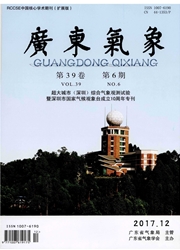

 中文摘要:
中文摘要:
利用实况观测资料和NCEP再分析格点资料,对2011年10月12—14日广东一场全省范围的暴雨过程及水汽特征进行了分析。结果表明:(1)此次暴雨过程分为2个阶段,分别是12日夜间的暖区暴雨和13日夜间的锋面暴雨。(2)第1阶段降水主要由500 hPa西风短波槽配合850 hPa东南风辐合导致的,第2阶段降水是高层西风槽过境,配合地面冷空气前锋南下和低层的切变线共同作用所致。(3)降水发生前广东水汽充沛,湿层从低层往上伸展的厚度大,估计约有50%的降水量可由雨区本地的水汽所提供。(4)低层850 hPa或者925 hPa的东南风是暴雨发生的重要水汽输送通道,暴雨发生前南海热带系统的活跃是维持850 hPa和925 hPa东南风输送的重要原因。
 英文摘要:
英文摘要:
Observations and NCEP reanalysis gridpoint data were used to study a torrential rain that took place across the province of Guangdong on October 12—14,2011. The results are shown as follows.( 1)This process can be divided into two stages,one being a warm-sector torrential rain on the night of October12 and the other being a frontal one on the night of October 13.( 2) The precipitation of Stage one is mainly caused by a westerly shortwave trough at 500 hPa associated with a southeasterly convergence at 850 hPa while that of Stage two results from the passage of a westerly trough at upper levels in association with the south-going surface cold air and a low-level shear.( 3) The water vapor is so rich in the province prior to the precipitation that a wet layer grows all the way upwards in large depth and about 50% of the amount of precipitation is supplied by local sources of water vapor.( 4) The southeasterly wind at the lower level of 850 or925 hPa is an important channel of transporting water vapor and the active tropical systems over the South China Sea prior to the torrential rain are greatly responsible for the southeasterly wind being transported constantly.
 同期刊论文项目
同期刊论文项目
 同项目期刊论文
同项目期刊论文
 期刊信息
期刊信息
